In this essay I present a model that describes how sexual reproduction may have evolved.
Understanding this evolutionary process is hard because the present state of sexual reproduction is multistage, costly, and its evolutionary progression is not easy to untangle logically from a natural selection cause and effect perspective.
The difficulty in making the connections is aggravated by the fact it is very likely that some of the evolutionary stages don’t exist anymore in extant species, and are tough to find in the fossil record, perhaps because they were ephemeral transitions in earlier evolution.
By using a gradual, small step-by-step approach, I divide the evolution of sexual reproduction in “eras” to show how each small innovation appeared. One of the key insights is that some steps were in a linear fashion, others in parallel, and others simultaneous by convergence.
The Model
The diagram below shows six eras, from binary fission asexual reproduction in a prokaryote ancestor to the complex, extra-stage meiosis in the current integrated sexual reproduction in eukaryotes.
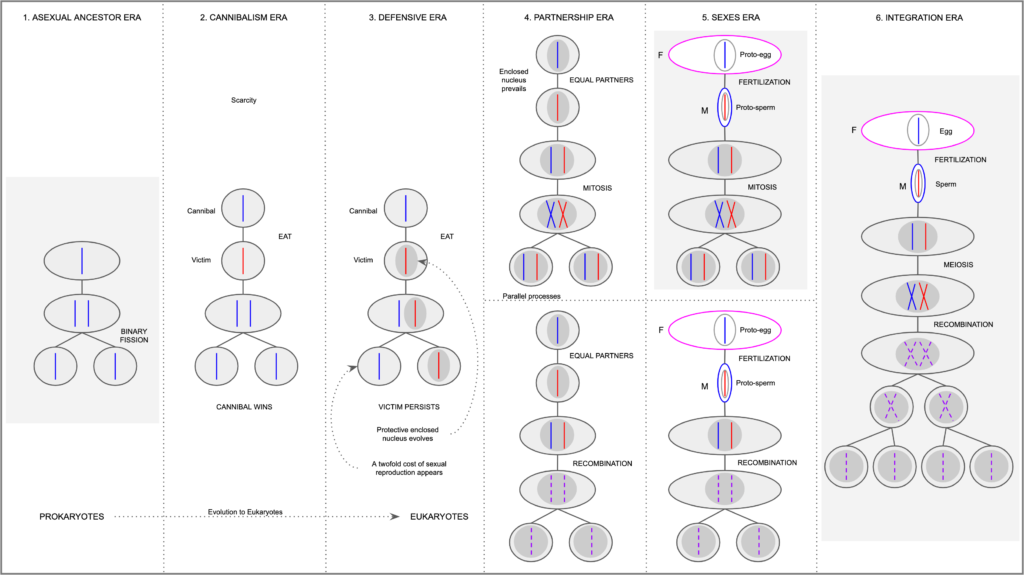
The diagram shows the transition from prokaryotes to eukaryotes with the evolution of the enclosed nucleus; the cannibalism, defensive, and partnership eras that very likely don’t exist anymore; the appearance of the sexes proper, in the sexes era; and meiosis, at the end of the process. The parts of stages shaded in grey are processes observable and common in organisms today.
1. Asexual Ancestor Era
In this era, the base state prokaryotic ancestor reproduced by binary fission into two identical daughter cells.

To achieve this it needed to replicate its DNA and grow the size of the cell until the division into viable offspring was possible. This era must have happened in a time and space of relative abundance of environmental resources, as the code replication and cell growth required needed their availability for reproduction at high frequencies and quantities.
2. Cannibalism Era
The cannibalism era is marked by scarcity of resources, either in the general environment or in specific regions.
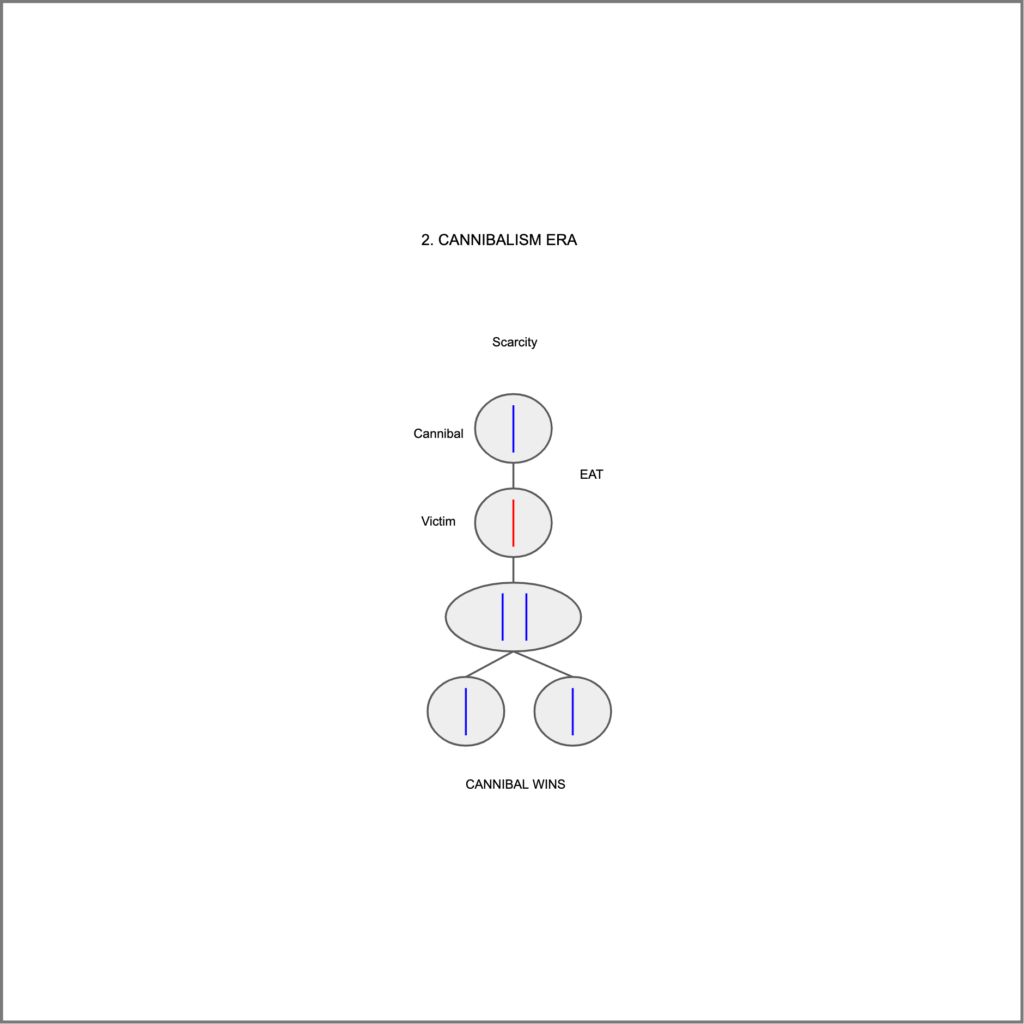
As a survival strategy, some prokaryotes, the cannibals, developed the ability to eat other prokaryotes, the victims, perhaps even of the same species due to proximity.
In this era the victim cells had no recourse when they were attacked and consumed. Their entire cells, including membrane, cytoplasm, DNA, and other components, were digested and reused as valuable resources by the cannibal, so it could be able to replicate its code, grow in size, and achieve a critical mass for binary fission.
In this era, the keys were the scarcity of resources and that the cannibal cell prevailed, in a tough environment, by procuring resources from the victim cell, achieving replication of its genes into two daughter cells.
3. Defensive Era
In an environment of continuing scarcity and facing a strong disadvantage, evolutionary pressure induced some prokaryotes to develop a sort of defensive shield, hence the name “defensive era”, to protect their DNA code.

This shield took the form of a membrane around the DNA that eventually formed an enclosed nucleus protecting it.
This meant that when a cannibal cell ate a victim cell with this new device, the victim cell lost all the parts of its organism, as before, except the nucleus with the cell’s DNA inside.
This ability eventually enabled the new eukaryote species not only to be able to preserve the integrity of its code, but also to pass it on to the offspring of the combined cell during reproduction.
However, because the resources of both cells were only enough to produce two daughters, one daughter had to inherit the DNA of the cannibal and the other of the victim, who was not, for all intents and purposes, a victim anymore.
As the new process, which can be classified as binary fission with a pair of DNA codes, required two cells, one cannibal prokaryote and one victim eukaryote, and the offspring is two daughters, one with the DNA of one “parent” and another with the DNA of the other, then it can be said that a sort of early twofold cost problem arouse.
However, the reason why this model was successful is because, in an environment of scarcity, the option of regular binary fission of single cells was very disadvantageous. In other words, the additional twofold cost was amply compensated by increased security of the new reproduction format.
Nevertheless, the evolution of eukaryotes, which were cells with a new enclosed nucleus containing their DNA, did bring the demise of cannibal prokaryotes. This shows the advantage of the twofold cost, because they incurred in such an expense, but without the enclosed nucleus security advantage: When they met other cannibals and were eaten, their DNA was not preserved.
The last point above probably made this era very ephemeral, because it was not an evolutionarily stable strategy, as the new eukaryotic cells were well positioned for collaboration in the next era, rather than predation, so their vulnerable neighbor cannibal prokaryotes must have disappeared pretty quickly.
The key points in this era are that scarcity of environmental resources was a constant; that the victim cells’ DNA persisted and reproduced by developing a protective enclosed nucleus; that the twofold cost was introduced but was warranted by the ample gains in security for the new eukaryotic cells; and that, precisely due to the twofold cost, this period must have been ephemeral because the old prokaryotic cannibals must have been quickly extinguished, digested by their peers, with no preservation of their code.
4. Partnership Era
In the partnership era the relationship between eukaryotes, in a continued environment of scarcity, became more of a collaborative process.
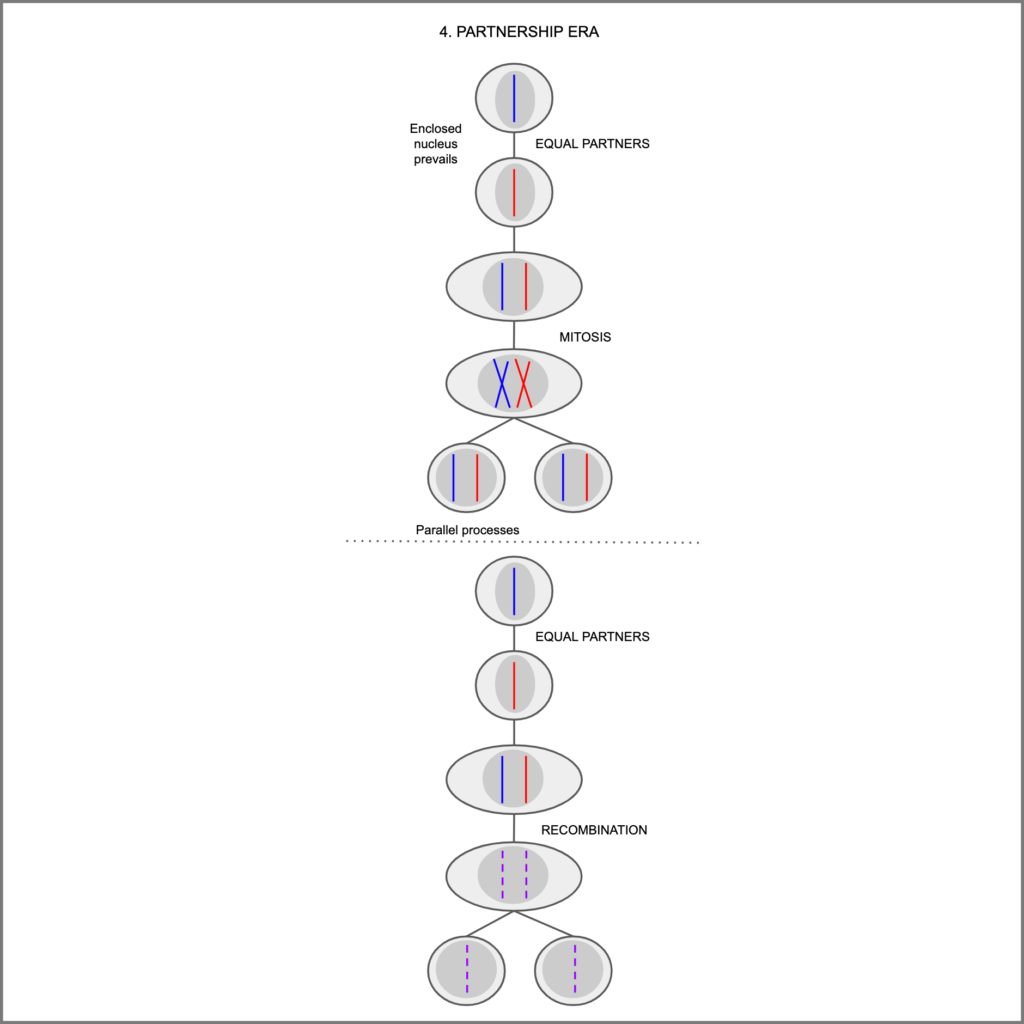
This means they became partners, rather than predator and prey. In this scenario, their DNA codes were sufficiently similar so they could be compatible, and both had enclosed nucleus protecting their DNA for enhanced security.
During this period two parallel reproductive strategies evolved, mitosis and recombination, each with its own advantages and disadvantages. However, both strategies remained distinct and separated until a future moment of integration, as one could not have given way to the other. This may be a reason why this era was also temporary and disappeared, as it was not an evolutionarily stable strategy either.
The first one, mitosis, is the most common in eukaryotic cells today, and is a relatively simple upgrade from binary fission. It involved the previous combination of the chromosomes of two partner cells, the parents, into one nucleus. Then, the chromosomes of both parents were replicated within the new nucleus, after which process it was divided into two. Finally, the enlarged cell, containing the two nuclei, was divided into two daughter cells with identical chromosome pairs from the two parents in their respective nuclei.
Mitosis, in this era, was not followed by recombination yet, but had the advantage that 100% of the two very similar chromosomes from different parents were preserved in the two offspring. This happened even in an environment of scarce resources due to the combination of the bodies of the two parents. The chromosome pairs in both daughters continued to be protected by a nucleus, and each set served as backup for the other in case of future accidental errors or mutations.
The disadvantage of mitosis was that it didn’t provide for many partnerships of different cells. This is because, when two parents fuse into a larger cell, the future cells just reproduce asexually. However, multi cellular organisms used and still use mitosis for their general structure, so the strategy still had ample benefits.
The second strategy in this era, recombination, did not produce daughter cells with pairs of chromosomes from both parents, nor were the cells useful for general structure. When the original partner cells fused into a larger cell, with a single nucleus with enough resources to reproduce, the chromosomes from both parents recombined and then divided into two daughters with two nuclei with single chromosomes sets, not pairs, from the combined DNA from both parents.
The disadvantage, as compared to mitosis, was that only 50% of the DNA of a parent cell was expected to be present in a daughter cell.
The advantages of recombination as a reproduction strategy were that there was a combination of code from two parents in each generation; it could serve as a defense against parasites that had already deciphered the code of the parents; and the diversity in new frequently combined formats may have accelerated variation, thus innovation.
The keys in this era are that scarcity of resources were persistent, so partnerships between eukaryotes were needed; that all participant cells were eukaryotes as the enclosed nucleus design prevailed; that there were two parallel and distinct reproduction strategies, mitosis and recombination; that mitosis provided for the preservation of 100% of chromosome pairs in each offspring; that it did not enable continued pairings as it was followed by asexual reproduction; that mitosis enabled the formation of general structure cells; that recombination enhanced security as it protected from parasites and provided diversity, which allowed variation, thus innovation; and that recombination only passed 50% of the parent’s DNA to the offspring.
The fact 100% of DNA of both parents was passed to offspring in mitosis, but only 50% in recombination meant that the former had a onefold reproduction problem and the latter perpetuated the twofold problem that appeared in the previous era for the cannibal prokaryotes.
5. Sexes Era
In the sexes era, the two parallel reproduction strategies of the previous era, mitosis and recombination, were not changed. What changed were the shape and form of the two partner cells, which migrated from being equal partners to different specialized cells: Male and female.
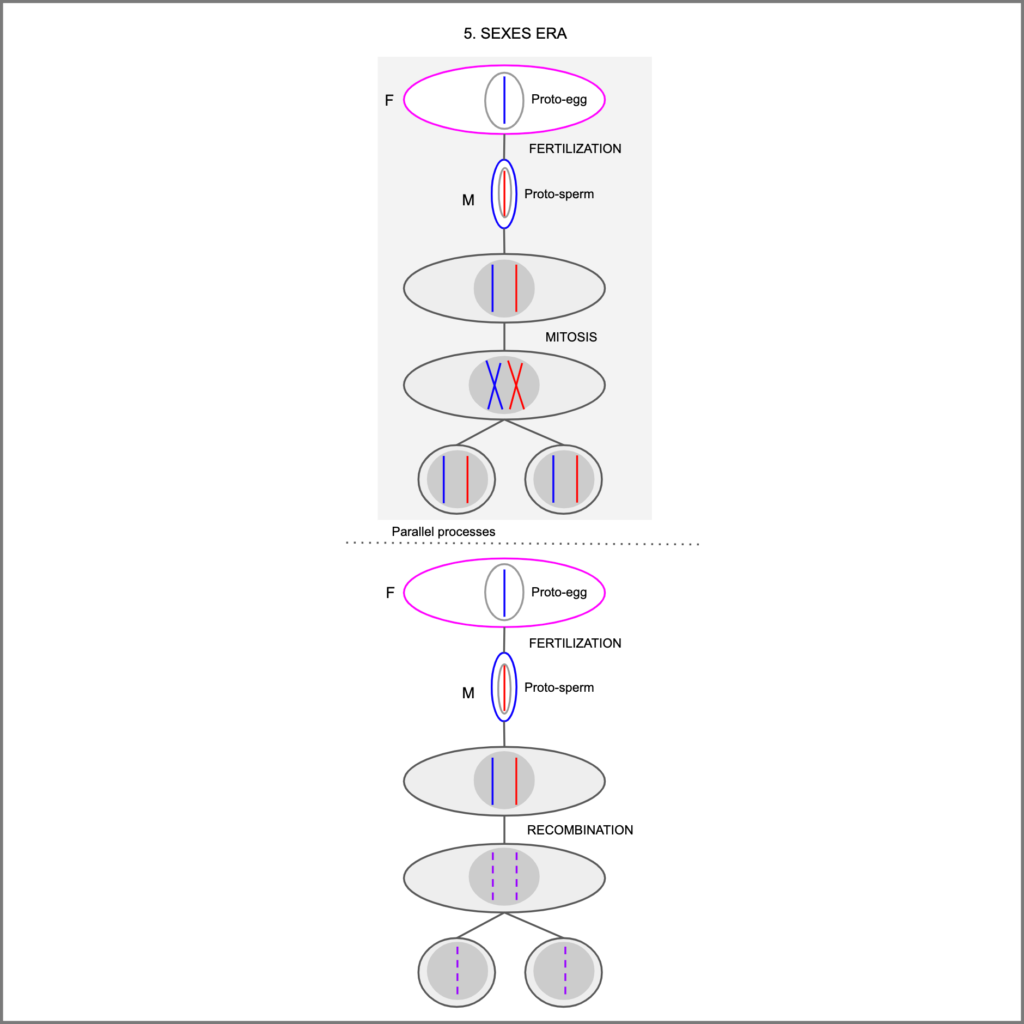
This process of specialization occurred by convergence in cells of both the mitosis and recombination reproduction types, as competition for partners and for resources were two very different specializations that resulted in high selection pressure to divide labor.
To compete for resources, the female cell, or proto-egg, was basically the same as before, but evolved to be much larger than the male cell, so it could count with all the resources for reproduction by herself, without the uncertainty of depending on extra resources from the male.
This kind of cell was less mobile and agile, and perhaps less ubiquitous, but it depended less on others, at least for resources. In a way it is a return to the ancestral model where the resources of other cells were not required. This may indicate either an increase in resources in the environment or a tradeoff made between partners where one got all the resources and the other got to be more mobile and agile. This tradeoff may have given advantages to both partners in different ways.
To compete for mating partners, the male cell, or proto-sperm, was also the same as before, but much thinner, mobile, and agile, which gave it the advantage of speed over other males when searching for females.
In this era, as female cells had their DNA, and perhaps sufficient resources to reproduce, but still needed the male DNA to do it, what was called “partnership” in the previous era, could be called “fertilization” in this one as it was only a DNA code contribution by male cells.
The keys in this era are that the two reproduction strategies continued unchanged as before and distinct from each other; that the previous equal partner eukaryotic cells, to allow for division of labor, pursued different strategies in terms of size and mobility, giving rise to males and females; that this specialization occurred by convergence in both cells reproducing by mitosis and by recombination; that these strategies made the female cell larger and less mobile, but with more resources for reproduction; that these changes made the male cell smaller and more mobile, so it could compete with other males when seeking for mating partners; and that because males basically contributed DNA, but very little or no resources at all, the process of putting together the DNA of two cells may be called fertilization.
6. Integration Era
In the integration era, two things occurred: The process of mitosis changed a little to give way and accommodate for the slightly different initial phases of meiosis, and the process of recombination was added in the second part of the meiosis process, but this time recombining identical pairs of sister chromatids united by a centromere.
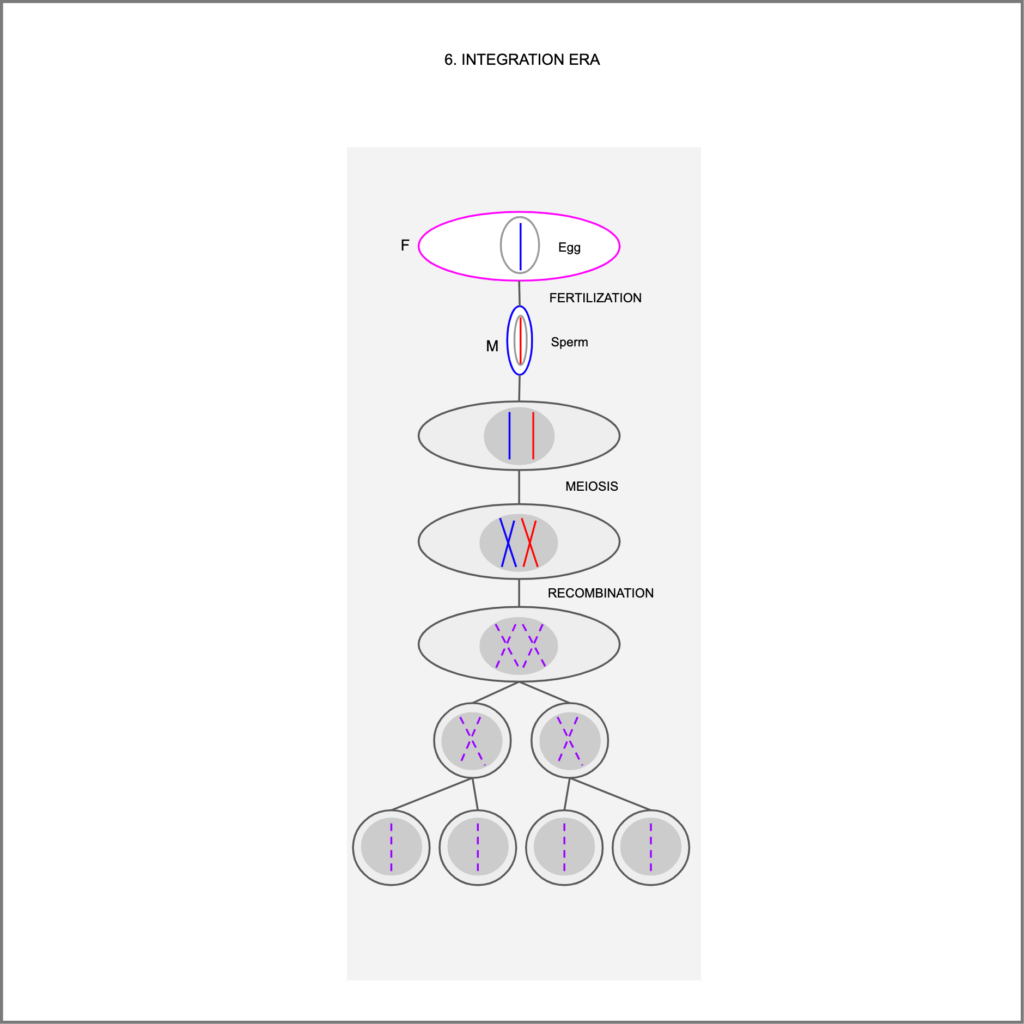
The full process was that a male cell, a sperm, fertilized a female cell, the egg; this put together their DNA in a combined nucleus in the female cell; the chromosomes were duplicated inside the nucleus; the duplicated sister chromatids connected through their centromeres and aligned with the other pairs for recombination; the male and female chromosomes were recombined by having their genes crossed over and mixed with the other chromosomes; separated and divided the recombined chromosome pairs into two cells; and, finally, divided those cells again into tow, so four haploid daughter gametes with only one set of chromosomes, instead of pairs, were created by the end of the process.
It is important to note that mitosis from the previous era also coexisted with the new meiosis system. In multicellular organism, for example, both reproduction systems coexist today, as general organism structure cells reproduce by mitosis, and gametes for sexual reproduction are created through meiosis.
The keys of this era are that the process of mitosis was adapted to facilitate meiosis; that recombination was added at the second part of meiosis; that the combined process had a chromosome duplication step and a chromosome recombination step; that an additional step to create four daughter gametes from the initial two daughter cells was added; and that the older mitosis form of reproduction still prevailed as multicellular organisms used both mitosis and meiosis for cell reproduction.
Summary
The model presented in this essay starts with a prokaryote ancestor and ends with an eukaryote meiosis process which gives way to further sexual reproduction. The pressures that induced prokaryotic cells to develop the enclosed nucleus and sexual reproduction, in the form of combining DNA code from separate individual cells, were likely the scarcity of environmental resources and the consequent evolution of predatory cannibal prokaryotes.
Both the enclosed nucleus and the ability it enabled to preserve DNA code to pass through to the offspring, after sacrificing the rest of the cell to the digestion of the predator, are devices that significantly increased security of the newly evolved eukaryotic cell.
Although an evolutionary twofold cost appeared at an early stage in sexual reproduction, the security enabled by that investment more than offset its cost. In other words, it was not a real advantage that regular cells could reproduce more and faster because the resources were not available anyway. Therefore, the lack of the new evolutionary devices represented not a mere advantage, but the difference between existing or not.
After the evolution of enclosed nuclei, the cannibal prokaryotes did not have a chance to compete with eukaryotes as they had no way of compensating for the twofold cost. This gave way for eukaryote-to-eukaryote collaboration by partnering to continue combining their DNA codes, but this time they evolved other reproduction strategies, which were mitosis and recombination. However, in this era, those processes were separated and parallel as one could not have given way to the other.
True sexual reproduction per se, in the form of male and female cells with division of functions and the requirement of fertilization, appeared at the end of the process by emergent evolution, as competition for partners and for resources were two very different specializations.
After all the previous eras and stages, the six step meiosis type of cell division was finally integrated, with a few modifications, by the mitosis and the recombination processes, to form the key part of current observable reproduction system in all eukaryotic single-cell and multicellular sexually reproducing organisms.
Mitosis continued as an asexual reproduction strategy, especially for general structure cells in multicellular organisms. Meiosis remains as a gamete production system for further sexual reproduction, during fertilization, where male and female gametes fuse to create cells with two copies of each chromosome, the zygotes.
Code Is Law